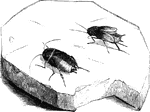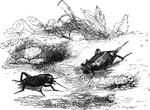Clipart tagged: ‘Orthoptera’

Common Cockroach
"Blattina includes the Cockroaches, the most noted species of which, the Black beetle or Common…

Female Cockroach
Cockroaches belong to the order Orthoptera. Cockroaches are harmful to plants in every stage after leaving…

Field Cricket
"Another species of cricket is the Field-cricket, a timid animal which avoids the society of man, living…

House Cricket
House crickets are in the order Orthoptera. Crickets are destructive to plants in every stage after…
!["Like that animal [the mole] it is constantly engaged in burrowing in the earth; and to enable it to do this with facility iits anterior limbs are converted into a pair of flat, fossorial organs, which are turned outward in exactly the same manner as the hand of the mole. In its pasage through the earth it does great injury to the roots of plants, but it said to live quite as much upon animal as vegetable food." — Goodrich, 1859](https://etc.usf.edu/clipart/14900/14935/molecricket_14935_mth.gif)
Mole Cricket
"Like that animal [the mole] it is constantly engaged in burrowing in the earth; and to enable it to…

Snowy Tree Cricket
A tree cricket that lives in trees and shrubs. They feed on plant parts, other insects, and fungi.

Earwigs
"The Foficulina includes the Earwig, Forficula, which appears to live principally upon vegetable…

Grasshopper
The male grasshopper makes noise by rubbing together hard plates on the inside of the thighs.

Carolina Grasshopper
"The Carolina Grasshopper, Gryllus Carolina, is a large species with brown wings, common in…

Green Grasshopper
Grasshoppers belong to the order Orthoptera. Grasshoppers have mouths fit for biting, net-veined wings,…

Locusts
"Locusts, which, from their often collecting in vast swarms, and moving onward with a steady and irresistable…

Praying Mantis
"The Mantis is one of the most voracious of its class, and only assumes this solemn and devout appearance…

Walking Leaf
"The Phasmina includes some curious insects, one species of which is the Walking-leaf, Phyllium…